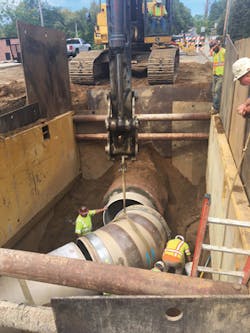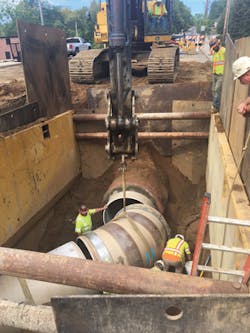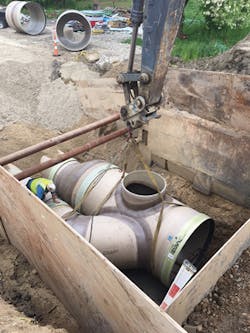CSO Project Benefits from Last-Minute Design Change
About a quarter of Akron, Ohio’s existing sewer system had been designed as combined sewers when constructed in the early 1900s. As a result, frequent overflows mixed stormwater with sanitary sewage. This mix ultimately emptied into the Cuyahoga River, the Little Cuyahoga River, the Ohio and Erie Canal, and Lake Erie, and prompted the Environmental Protection Agency (EPA) to issue a federal mandate to end pollution in local waterways and comply with Clean Water Act requirements.
As part of the solution, the City of Akron created the program “Akron Waterways Renewed!” to control combined sewer overflows (CSO) and improve water quality in nearby rivers. A portion of that plan was to create a 6,240-foot-long Ohio Canal Interceptor Tunnel (OCIT); construct three new storage basins; upgrade CSO racks; and upsize and reinforce the main outfall sewer cap.
The 27-foot-diameter OCIT sections were a feat in themselves, dug with a massive tunnel boring machine and constructed of reinforced concrete pipe (RCP). The basins will hold combined sanitary and stormwater overflow until it can be safely released to Akron’s wastewater treatment facility.
Of particular interest is the design and construction of the influent line to the new Howard Storage Basin (CSO Rack 22) at the intersection of Howard and Cuyahoga Streets, which will provide temporary storage of combined sewer flow from the North Hill tributary area. With a 2.4-million-gallon capacity, it is the largest of the three new storage basins.
HM Miller Construction was subcontracted for the site work for CSO Rack 22, one of Akron’s 34 sewer separation units, as well as relocating the existing waterline to accommodate influent piping. The HM Miller engineering staff saw a potential problem with the original design, which called for elliptical RCP influent line to run beneath Cuyahoga Street. According to John Smith, president of HM Miller Construction, they realized that there would be difficulty in achieving clearance under the public road, even though the RCP line would be elliptical, and that could lead to the inability of the RCP line to pass the required pressure test specification.
Smith called upon his resources at Hobas to assist in devising an alternate plan for CSO 22 that would resolve the inherent difficulties surrounding installation and testing using the RCP. Together they came up with a design that saved time and money, tying the Howard Storage Basin into the main line. In place of the elliptical RCP originally specified to be installed under Cayahoga Street, the new design called for twin 57-inch Hobas CCFRPM pipe that would tie into the OCIT-1 main line with a concrete collar subsequently designed by the project engineer.
In a true instance of teamwork, the owner (City of Akron), design engineer (DLZ/McMillen & Jacobs/Jenny) and construction manager at risk (Great Lakes Construction Co.) accepted the alternate plan submitted by the subcontractor. WW
Hobas Pipe is exhibiting at WEFTEC.18, booth 6129. For more information, visit hobaspipe.com.
Circle No. 303 on Reader Service Card


